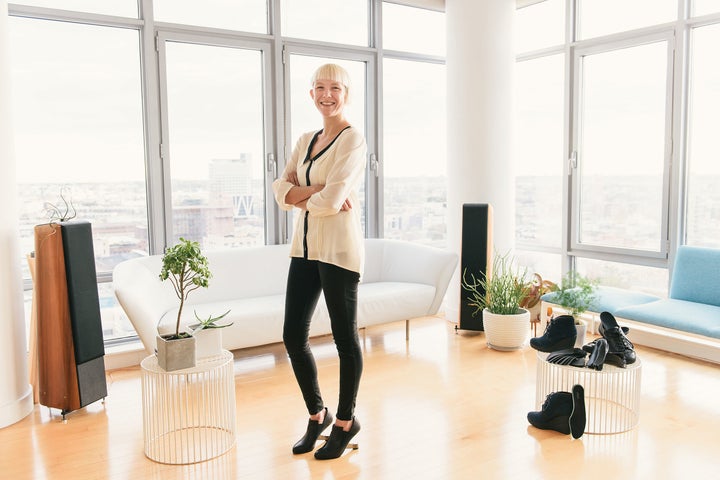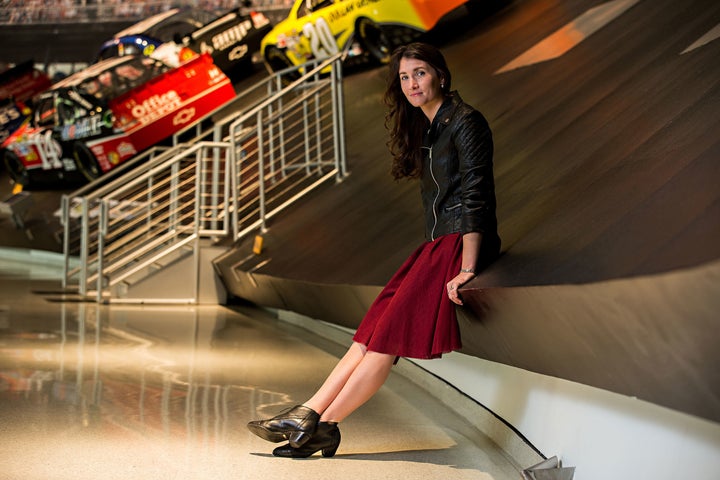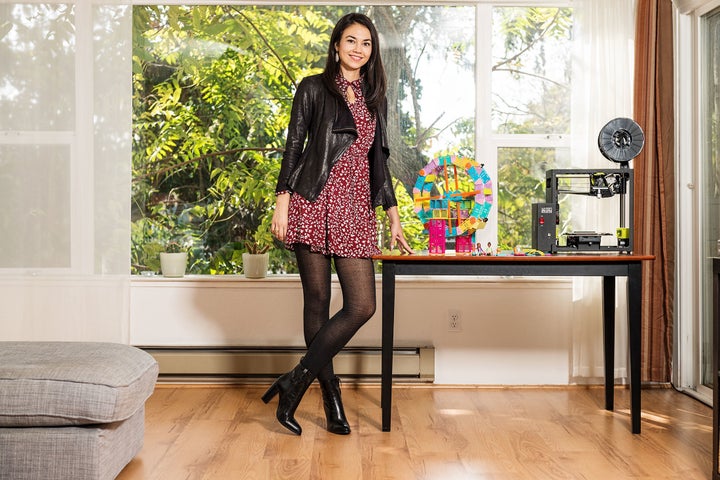Women-led businesses are on the rise. From 2007 to 2012, the percentage of companies helmed by females jumped by 7.5 percent, to over a third of all business, according to data from the National Women’s Business Council. And with more women now running the show, outdated industry norms have been rightfully disrupted, including around workplace fashions.
To celebrate the undoing of old sartorial standards, we teamed up with ModCloth and spoke with three empowered female entrepreneurs from three diverse industries, and discussed how modern women dress for success in their personal and professional lives. Meet Kegan Schouwenburg, co-founder of SOLS, a company that makes personalized orthotics using 3D printing; Julia Landauer, the Stanford-educated stock car driver; and Alice Brooks, a mechanical engineer and co-founder of Roominate — a building toy that’s designed especially for girls. Who runs the world? These stylish and business-savvy women are certainly well on their way to domination.
Kegan Schouwenburg, 31, CEO And Co-founder Of SOLS

What pieces of clothing or accessories make you feel powerful?
Jumpsuits have a great balance of professionalism and femininity. I feel like they accomplish what a pantsuit tries to do without being a pantsuit.
In what ways is your workwear is a reflection of your industry? Of your company?
I think my workwear, my haircut and my style in general really reflect my background in 3D geometry. They’re more focused on interesting forms rather than color and pattern, which is consistent with what our company values. How I dress empowers me to take on the day, feel comfortable in my body, and not shy away from risks. We’re in an industry that values innovation above all else, and our company does, too. I like to think that’s reflected in what I put on day to day.
You’ve managed to make orthotics — sometimes associated with a certain level of frumpiness — techy, sexy and cool. How did you tackle the image of your product?
Overlooked product categories are the most exciting ones. With orthotics, no one was paying attention. Even when we raised our first funding round, people said, “Do they really need to be beautiful? Aren’t they just going in your shoe?” For me, everything is worthy of consideration. I want to get up everyday and put on products that help me look and feel great. Frumpy, bulky orthotics just don’t cut it. We spend SO much time on our feet, why be uncomfortable?
As a CEO, what does being a good leader mean to you?
It means responsibility, ownership and leading by example. The buck stops with me, and I take that seriously. I feel a lot of pride in my team and I feel responsible for their success—that’s something that motivates me everyday. I always joke that they do the work and I make spreadsheets. I do whatever’s leftover and needs to be done—that to me is being a leader.
Have you encountered challenges based simply on the fact that you’re a woman in tech?
ABSOLUTELY. [Technology]is a male-dominated field. Try being the only woman in a room full of Harvard- and Stanford-educated 20-something white men. It’s rough. That said, I don’t spend much time thinking about it. I just do my thing and it seems to work.
What’s next? Do you see any other applications for 3D printing in your future?
We love 3D printing and there’s always going to be more applications for it. Right now we’re excited about solving discomfort, and at the root of the problem is fit. We want to help the industry evolve from mass-manufactured to made-for-me, and we want to do that through our software. We’ll be launching a new product, SIZERIGHT, at the beginning of 2017. It’s focused on helping customers get the best fit for their shoes. We can’t wait to share more details on the platform and app.
Julia Landauer, 24, Professional Stock Car Driver And Motivational Speaker

Do you have your own version of a work “uniform?”
I wear my fire-resistant racing suit at work. Beneath that there’s a fire-resistant shirt, pants and socks. Then I have my fire-resistant gloves, shoes, helmet and a head sock that helps keep my hair out of my eyes. Then when I’m flying to a race, I have my team polo with skinny jeans.
What pieces of clothing or accessories make you feel powerful?
A well-fitted, longer blazer with an ankle boot makes me feel very confident. It’s a feminine but put-together look. Also, I have a statement ring with a large black stone that I got in Malaysia that makes me feel powerful ... it’s not what you’d consider traditionally business appropriate ― but, because I’m writing my own rules for my career, it gives me the feeling of being in charge.
As a woman in a male-dominated field, do you ever worry about how you’ll be perceived based on how you dress?
At first, when I was breaking into the NASCAR scene, about two or three years ago, I was much more conscious of it. But I’ve since found there’s more power in showing my true colors. I go for a feminine but respectful look.
What’s the best career advice you’ve ever heard?
That nobody is just going to give you what you deserve; you have to take what you deserve, demand it. You need to be your biggest advocate and biggest soldier. Especially as women, we’re less likely to ask for what we want and what we deserve, so people know they can give us less and we’re probably not going to fight for it.
What are you most proud of?
I’m proud of getting my Bachelor of Science and I’m proud of the championships I’ve won. But I think in the overarching scheme of things, I’m [most] proud of how hard I’ve worked and how much I’ve persevered.
What’s it like in the seconds right before a race starts?
I typically get knots in my stomach. I get nervous and I feel the physical effects of that. So, the moments before I race, I’m taking a deep breath, but then also getting really excited. I shift from being nervous to thinking, Alright, we’re going to go out there and race. I start thinking about passing people or getting a good start and getting ready to go kick butt.
Who are your mentors or role models?
I’m really lucky to have great mentors, some from Stanford, some in the racing industry. For mentors, one of my biggest is Lyn St. James. She was a racer in the ’70s, one of the earlier women to be in racing, and she [raced an] IndyCar. I’ve known her since I was 13, and she’s been so helpful because she’s been through it before.
As for role models, there’s Paul Newman, who epitomized the idea of dreaming big and going after it — he did so much and gave back to the community. He’s such an incredible person to model your life after. And then the other big one for me is Amelia Earhart. She was told “no” left and right and she didn’t care; she did it anyway and she did something that was very challenging and technical and took the risks that were involved. Talk about an early badass woman.
You’ve said before that “niceness loses races.” Is it possible to be nice and successful?
I totally think it’s possible to be nice and successful. But I think being nice and being well-liked can’t be the primary focus; they can’t be the priority. I think you can be respectful, caring and curious. My issue with niceness is that I end up not prioritizing the more proactive traits that I need to succeed.
Alice Brooks, 28, Mechanical Engineer And Co-founder Of Roominate

Do you have your own version of a work “uniform?”
I love shopping, so I have a lot of clothes, but if I don’t have time to really think about it, I usually wear jeans, a T-shirt, and then either a casual blazer or a casual jacket.
In modern offices, the boundary between “work clothes” and what you’d wear on the weekend has become blurred. As the head of a company, do you think eliminating traditional dress codes is a good thing? Does it help foster creativity?
I think so. Also, a big part of what we do is user testing with kids, so you need to be comfortable because you’re crawling around on the floor or showing them how to use the different products. Plus, with Roominate, our goal is to empower little girls and get them exposed to more opportunities, and part of that is showing them that you can dress up and be girly or you can be a tomboy. There isn’t one specific way that you have to be.
In what way is your clothing choice a reflection of your industry?
My work is very creative in a lot of aspects, between the actual physical design of the toys and figuring out how we’re going to market them and get them out to people. I think picking clothes and deciding what to wear is a different form of creativity.
What pieces of clothing or accessories make you feel powerful?
I’m 5’10” and I always feel powerful when I wear heels. It’s instant. There’s been a couple times when I’m wearing heels to meetings and someone’s made a comment like, you’re so tall! Don’t be so tall! I actually like that — it makes me feel stronger.
As a woman in tech and engineering, have you seen any changes in the fields since you got your degree from MIT in 2010?
[They] still [feel] very male-dominated, in terms of numbers; but the conversation about getting more women interested has become much more prominent in the last few years, and I think the opportunities for girls have opened up so much recently.
You started Roominate in 2012, so there is currently a generation of girls growing up with these toys. How do you think this group will be different from the generations before?
The goal is that they’ll be open to trying more things. Roominate is very doable for a 6-year-old playing independently, so she can build up her confidence and figure out how things go together, or how to plug in a circuit and make a motor work. There’s a real sense of accomplishment that can come from that.
Who are your mentors and role models?
Two most important ones are my parents. My mom is a math teacher, and her philosophy when I was growing up was, If you don’t have it, don’t buy it — make it. My dad is a roboticist and he always encouraged me to try things that weren’t traditionally girly.
What’s the best career advice you’ve heard?
People that I met at Stanford through a startup accelerator … said, if you want do it, just go for it — otherwise someone else is going to do it. Even though I had no experience running my own company, I just went for it and couldn’t be happier about how it turned out.
What does the old saying “you should dress for the job you want, not the job you have” mean to you?
I already have the job I want! But one thing I consciously did along the way was dress how I wanted to dress. People were already taking me seriously, and if they were going to take me any less seriously because of something I wore, then it’s their own problem. Not mine.
Whether your workday takes place on the Indy 500 racetrack or at a San Francisco–based tech startup, ModCloth has the professional apparel to empower you to be your best self. Find Kegan’s chic white button-up blouse, Julia’s whimsical burgundy skirt, Alice’s trendy, printed dress, and more work wardrobe staples at ModCloth.com.